Stability Control of Retained Goaf-Side Gateroad under Different Roof Conditions in Deep Underground Y Type Longwall Mining
Abstract
:1. Introduction
1.1. Advantages of the Y Type Longwall Mining
1.2. Stability Control of the RGSG in the Y Type Longwall Mining
2. Research Methods
2.1. Deforamtion Model
2.2. Numerical Model
- (1)
- Considering the computing efficiency and accuracy, this model had 1,170,000 zones. Coal seam was 3.0 m thick, and gateroad was 5.0 m wide and 3.0 m high, and packfillings was 3 m wide and 3 m high. Displacement boundaries of the model were set as roller boundaries along sides, and pinned boundary along bottom. A vertical stress as much as 19.7 MPa was applied at the top of model to simulate the weight of overburden assuming the average density of the overlying strata is 2.2 × 103 kg/m3, and at-rest pressure coefficient was taken as 1.0. Longwall panel moved along the y direction.
- (2)
- In this model, immediate roof was mudstone and main roof was sandstone. To model the caving activity of the immediate roof and supporting of the caved rock mass to overlying strata, the immediate roof was also excavated together with the coal-seam, and the excavated space was filled with soft elastic backfilling [18], as shown in Figure 5. Whole thickness of the immediate roof and the main roof was set to be a certain value of 12 m, which is the thickness that the immediate roof needed to fully fill the excavated space when 3 m thick coal seam was mined, which was calculated according to the Equation (1) assuming the residual bulk factor of the caved immediate mudstone was 1.25. Seven types of the combinations of immediate roof and main roof were considered in this simulation, as shown in Table 1. The thickness of main roof increased as immediate roof became thin gradually, and the backfilling thickness was calculated in each situation according the corresponding thickness of the immediate roof.
- (3)
- Coal seam, immediate roof and floor strata were set as Strain Softening constitutive materials to simulate the plastic mechanics of these weak rock masses in deep mining environment. Other rock strata including sandstone, siltstone and packfillings were set as Mohr–Coulomb constitutive material. The mechanics parameters of all rock masses used in this model were collected according to the results of rock sample tests in lab and statistical investigation in field, and they are listed in Table 2 and Table 3.
- (4)
- Roadway support was installed according to the present criterion applied in eastern China: rock bolts (end anchored) with a diameter of 22 mm and a length of 2500 mm in roof with an inter-row space of 0.9 m × 0.8 m and in coal sidewalls with an inter-row space of 0.75 m × 0.8 m; cable bolts (end anchored) with a diameter of 22 mm and a length of 6000 mm only in roof strata and right coal sidewall, with an inter-row space of 1.0 m × 0.8 m. In the left coal sidewall, cable bolt was not installed because the obstruction to coal cutting. Roadway floor was not supported.
- (5)
- The simulation sequences are as follows: (i) generating initial stresses; (ii) excavating the gateroad and installing roadway support; and (iii) retreating coal panel and building the packfillings along the goaf side (Figure 6a). During coalface moving, abutment stress and deformation in roadway’s surrounding rock were monitored according to the measuring station and detectors shown in Figure 6a,b, and the monitored results were analyzed in Section 3.2 and Section 3.3.
3. Results and Discussion
3.1. Roof Structure over the RGSG as Roof Condition Varies
3.2. Deformation Evolution during Coal-face Advancement
3.3. Abutment Stress Evolution during Coal-face Advancement
4. Stability Control Technology of the RGSG under Different Roof Conditions
4.1. Staged Support Technology Involving Conventioal Bolts
4.1.1. Staged Support Technology
4.1.2. Field Application in Zhuji Coalmine
4.2. Staged Support Technology Involving Grout Cable Bolts
4.3. Hard Roof Structure Optimizing Technology Involving Pre-Split
5. Conclusions and Recommendations
- (1)
- As a result of rock strata movement over the goaf, a roof cantilever forms over the RGSG that is located at the side of goaf. The sinking and rotation movement of the roof cantilever weakens the rock surrounding the RGSG. This effect increases as the main roof becomes thicker and the immediate roof becomes thinner.
- (2)
- The influence of the abutment stress induced by coal seam mining on the RGSG can be divided into three stages: no influence more than 40 m ahead of the coalface or more than 120 m behind the coalface; slight influence 20–40 m ahead of the coalface or 60–120 m behind the coalface; and strong influence from 20 m ahead of the coalface to 60 m behind the coalface. These stresses produce large deformations in the rock that surrounds the roadway. As the thickness of the main roof increases and the thickness of the immediate roof decreases, these deformations increase considerably during the coal-panel mining. The maximum deformation of the rock surrounding the RGSG occurs when the RGSG is directly beneath the hard main roof of 12 m thickness.
- (3)
- Staged support technology involving conventional cable bolts cannot maintain the long-term stability of a deep RGSG. Roadway space enlarging including floor dinting and sidewall expanding has to be carried out because of large deformations before the second coal panel mining. Grout cable bolts can improve the flexibility of the deep RGSG by reducing the size of the plastic zone in the surrounding rock through providing large pull-put resistance and injection of grouts in the cracked surrounding rock. Roof structure optimizing technology involving pre-split can effectively improve the stability of the RGSG under hard roof strata by shortening the length of the hard roof cantilever.
Acknowledgments
Author Contributions
Conflicts of Interest
References
- Huang, J.; Tian, C.; Xing, L.; Bian, Z.; Miao, X. Green and Sustainable Mining: Underground Coal Mine Fully Mechanized Solid Dense Stowing-Mining Method. Sustainability 2017, 9, 1418. [Google Scholar] [CrossRef]
- Trubetskoy, K.N.; Ruban, A.D.; Zaburdyaev, V.S. Characteristics of methane release in highly productive coal mines. J. Min. Sci. 2011, 47, 467–475. [Google Scholar] [CrossRef]
- Li, S.; Shuang, H.; Wang, H.; Song, K.; Liu, L. Extraction of Pressurized Gas in Low Air-Conductivity Coal Seam Using Drainage Roadway. Sustainability 2017, 9, 223. [Google Scholar] [CrossRef]
- David, R.G.; Rafael, J. A probabilistic extension to the empirical ALPS and ARMPS systems for coal pillar design. Int. J. Rock Mech. Min. Sci. 2012, 52, 181–187. [Google Scholar]
- Zhang, N.; Zhang, N.; Esterle, J.; Kan, J.G.; Zhao, Y.M.; Xue, F. Optimization of gateroad layout under a remnant chain pillar in longwall undermining based on pressure bulb theory. Int. J. Min. Reclam. Environ. 2016, 30, 128–144. [Google Scholar] [CrossRef]
- Yuan, L. Gas distribution of the mined-out side and extraction technology of first mined key seam relief-mining in gassy multi-seams of low permeability. J. China Coal Soc. 2008, 33, 1362–1367. [Google Scholar]
- Yang, W.; Lin, B.Q.; Yan, Q.; Zhai, C. Stress redistribution of longwall mining stope and gas control of multi-layer coal seams. Int. J. Rock Mech. Min. Sci. 2014, 72, 8–15. [Google Scholar] [CrossRef]
- Peng, S.S.; Chiang, H.S. Longwall Mining; Wiley: New York, NY, USA, 1984. [Google Scholar]
- Qian, D.; Shimada, H.; Zhang, Z.; Sasaoka, T.; Matsui, K. Application of goaf-side roadway retained and new type ventilation system in deep longwall face. Mem. Fac. Eng. Kyushu Univ. 2015, 74, 100–116. [Google Scholar]
- Feng, X.; Zhang, N. Position-optimization on retained entry and backfilling wall in gob-side entry retaining techniques. Int. J. Coal Sci. Technol. 2015, 2, 186–195. [Google Scholar] [CrossRef]
- Tan, Y.Y.; Yu, F.H.; Ning, J.G.; Zhao, T.B. Design and construction of entry retaining wall along a gob side under hard roof stratum. Int. J. Rock Mech. Min. Sci. 2015, 77, 115–121. [Google Scholar] [CrossRef]
- Zhang, Z.; Bai, J.; Chen, Y.; Yan, S. An innovative approach for gob-side entry retaining in highly gassy fully-mechanized longwall top-coal caving. Int. J. Rock Mech. Min. Sci. 2015, 80, 1–11. [Google Scholar] [CrossRef]
- Wang, H.; Zhang, D.; Liu, L.; Guo, W.; Fan, G.; Song, K.; Wang, X. Stabilization of gob-side entry with an artificial side for sustaining mining work. Sustainability 2016, 8, 627. [Google Scholar] [CrossRef]
- Ning, J.; Wang, J.; Bu, T.; Hu, S.; Liu, X. An innovative support structure for gob-side entry retention in steep coal seam mining. Minerals 2017, 7, 75. [Google Scholar] [CrossRef]
- Brown, E.T.; Hoek, E. Trends in relationships between measured in-situ stresses and depth. Int. J. Rock Mech. Min. Sci. 1978, 15, 211–215. [Google Scholar] [CrossRef]
- Yang, S.Q.; Xu, P.; Ranjith, P.G. Evaluation of creep mechanical behavior of deep-buried marble under triaxial cyclic loading. Arab. J. Geosci. 2014, 8, 6567–6582. [Google Scholar] [CrossRef]
- Itasca Consulting Group Inc. FLAC3D (Fast Lagrangian Analysis of Continua in 3 Dimensions); Version 3.1 User’s Manual; Itasca Consulting Group Inc.: Minneapolis, MN, USA, 2002. [Google Scholar]
- Yan, S.; Bai, J.B.; Wang, X.; Huo, L. An innovative approach for gateroad layout in highly gassy longwall top coal caving. Int. J. Rock Mech. Min. Sci. 2013, 59, 33–41. [Google Scholar] [CrossRef]
- Bai, J.B. Surrounding Rock Control of Entry Driven Along Nest Goaf; Press of China University of Mining and Technology: Xuzhou, China, 2006; pp. 22–36. [Google Scholar]
- Utsuki, S. In-situ experimental studies on improvement of deformability of rock masses by grout treatment. Int. J. JSRM 2013, 9, 7–8. [Google Scholar]
- Zolfaghari, A.; Sohrabi Bidar, A.; Maleki Javan, M.R.; Haftani, M.; Mehinrad, A. Evaluation of rock mass improvement due to cement grouting by Q-system at Bakhtiary dam site. Int. J. Rock Mech. Min. Sci. 2015, 74, 38–44. [Google Scholar] [CrossRef]
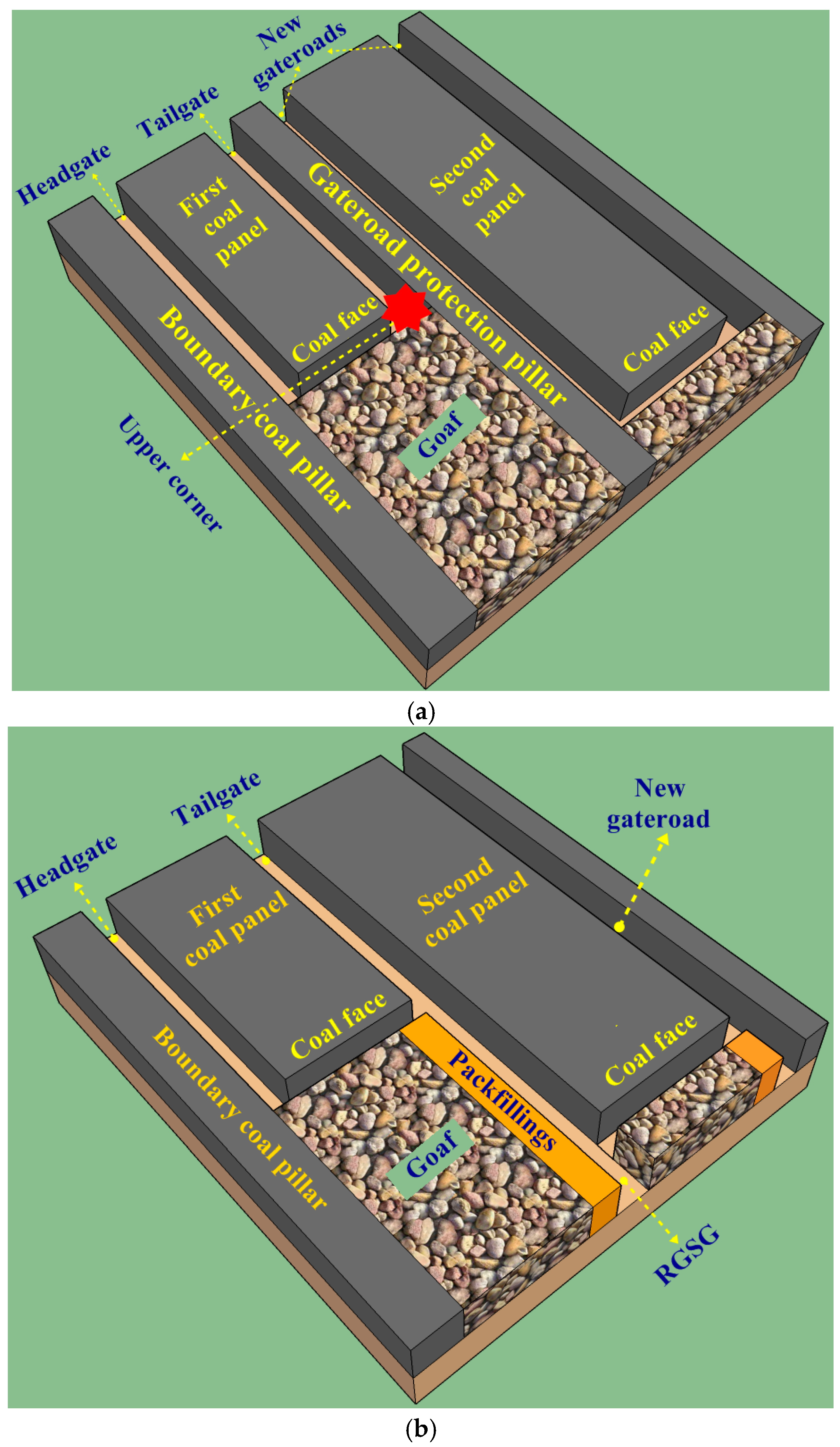



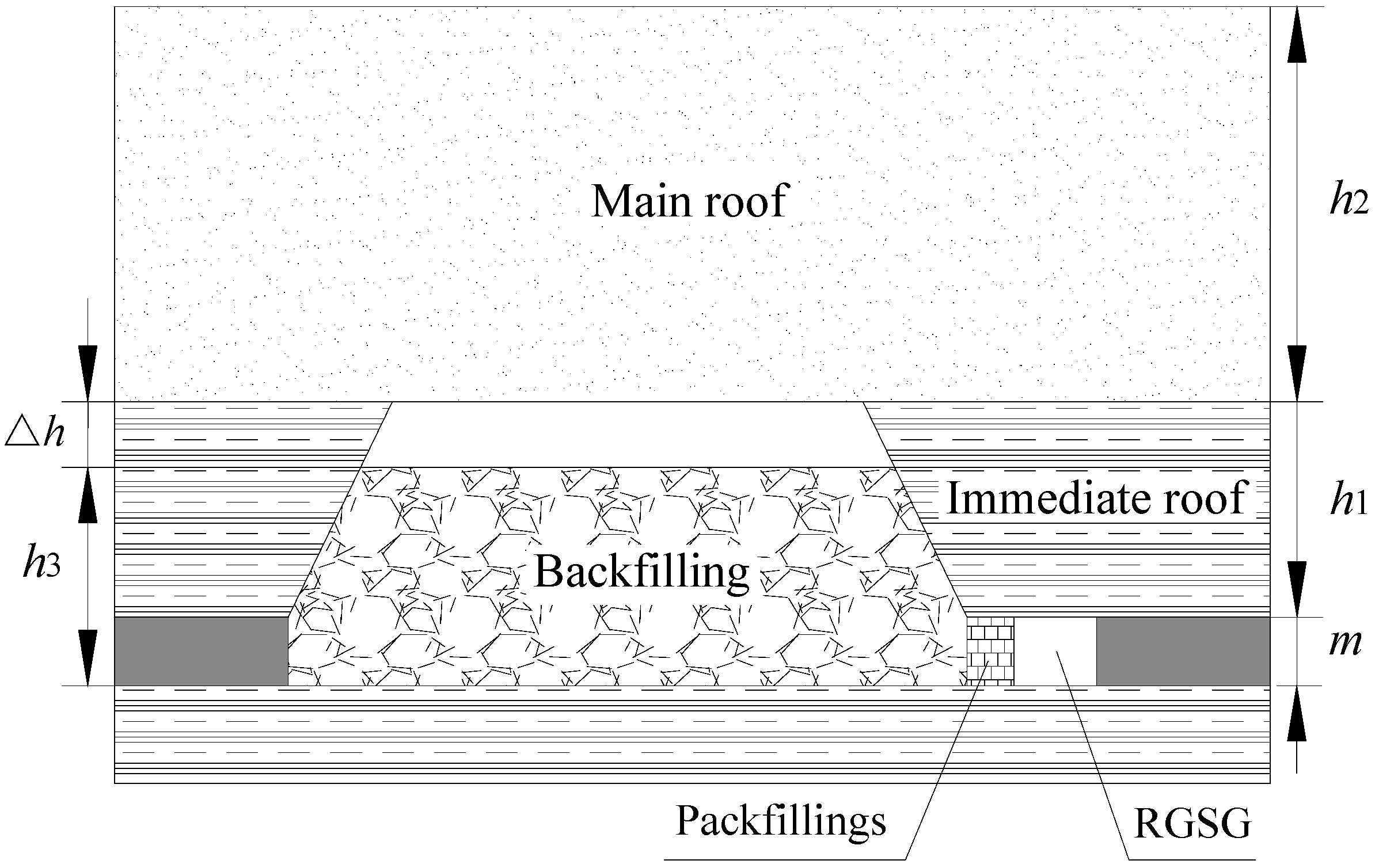
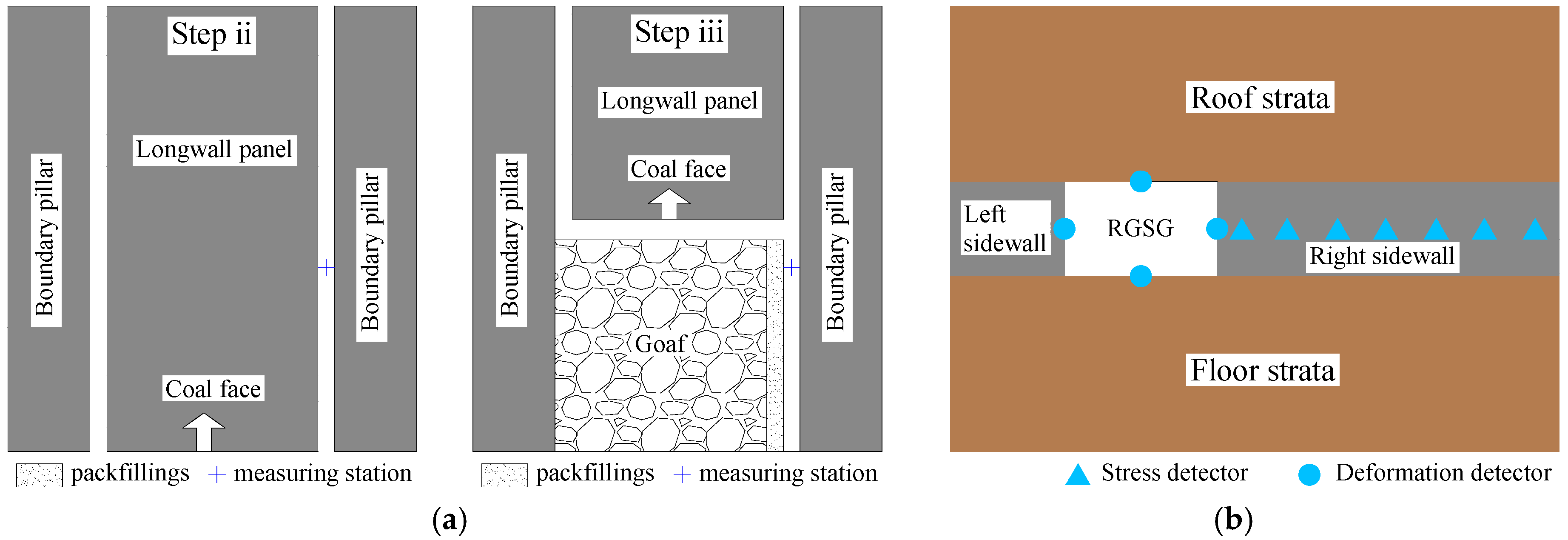
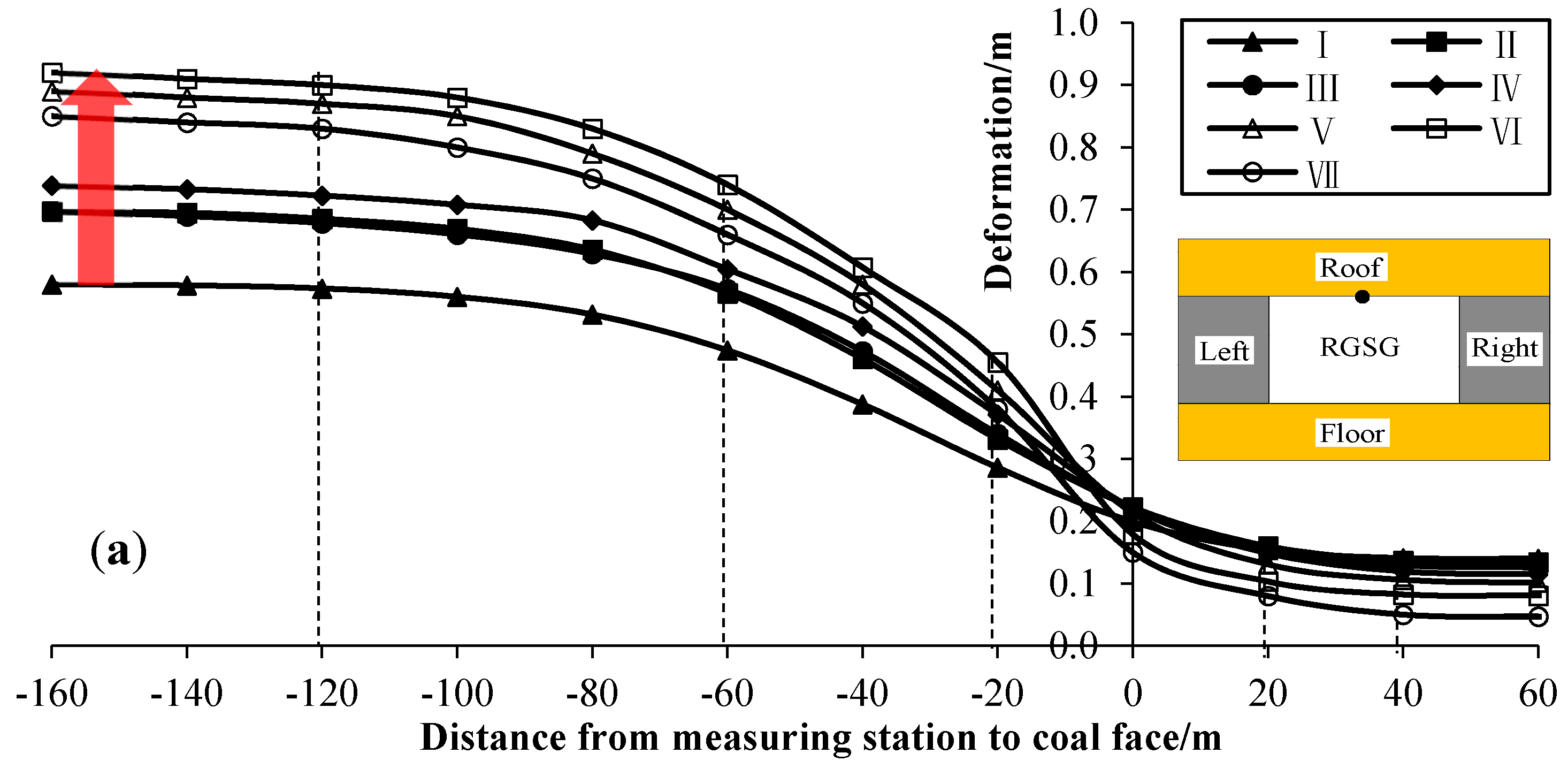
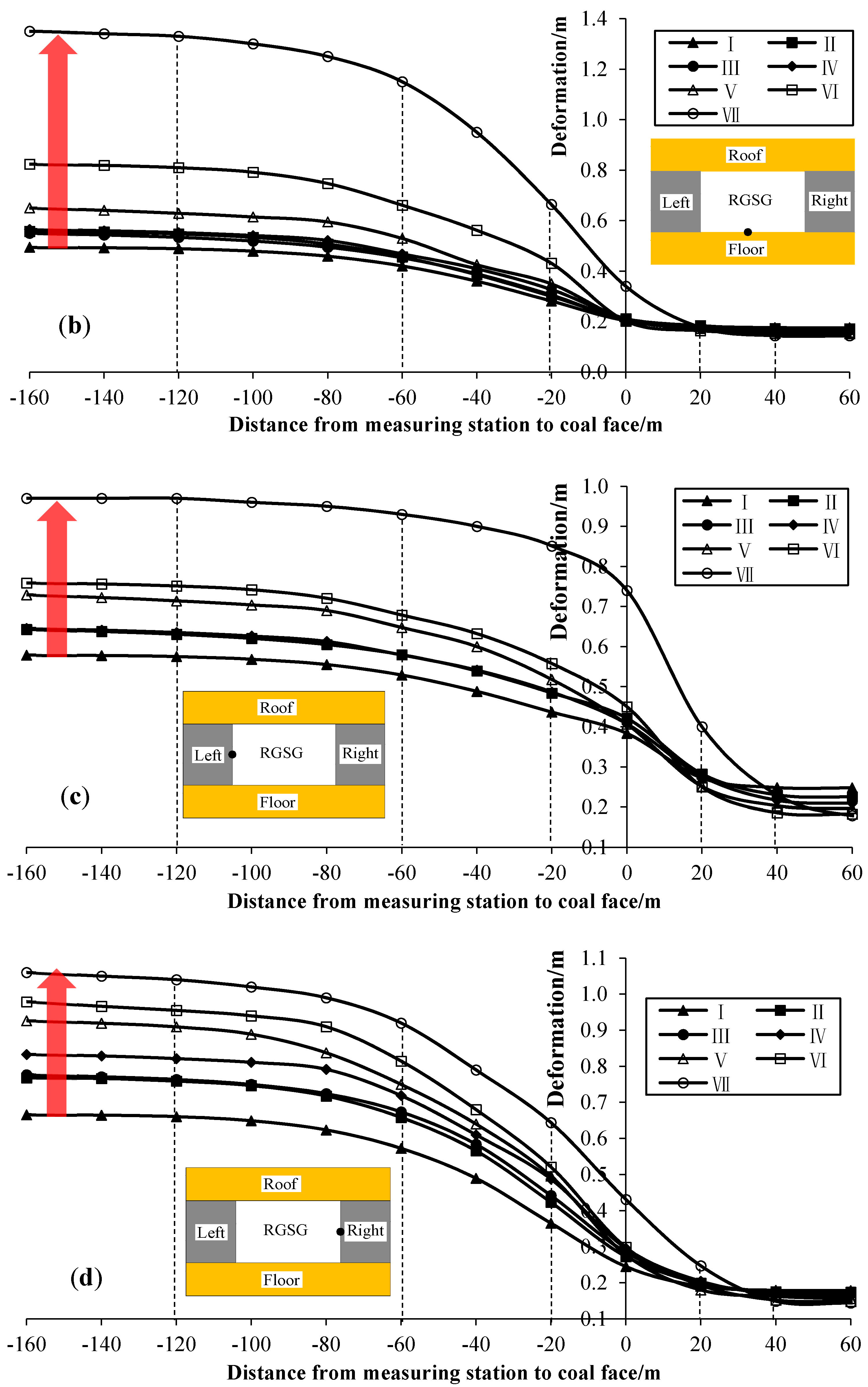

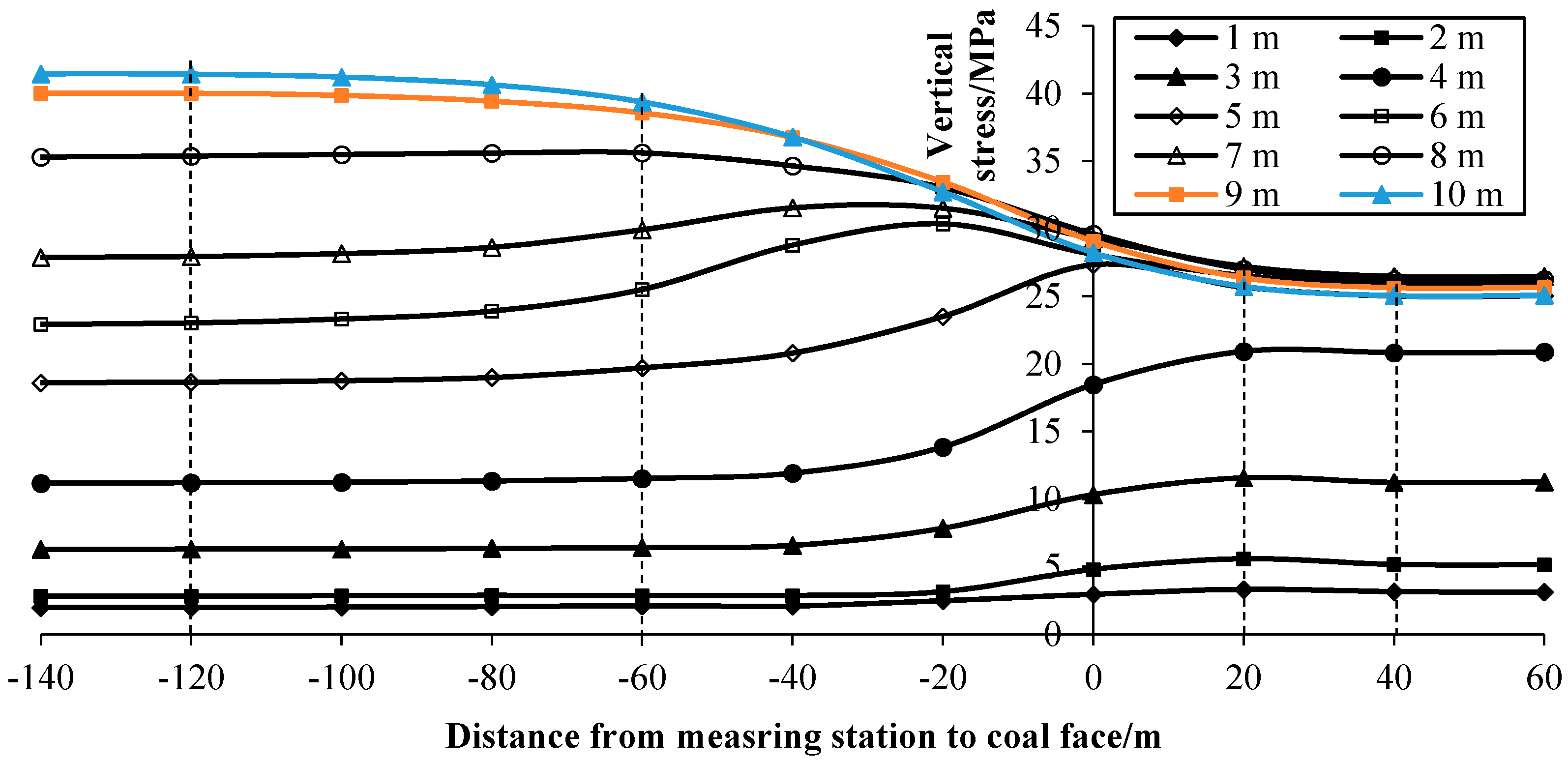
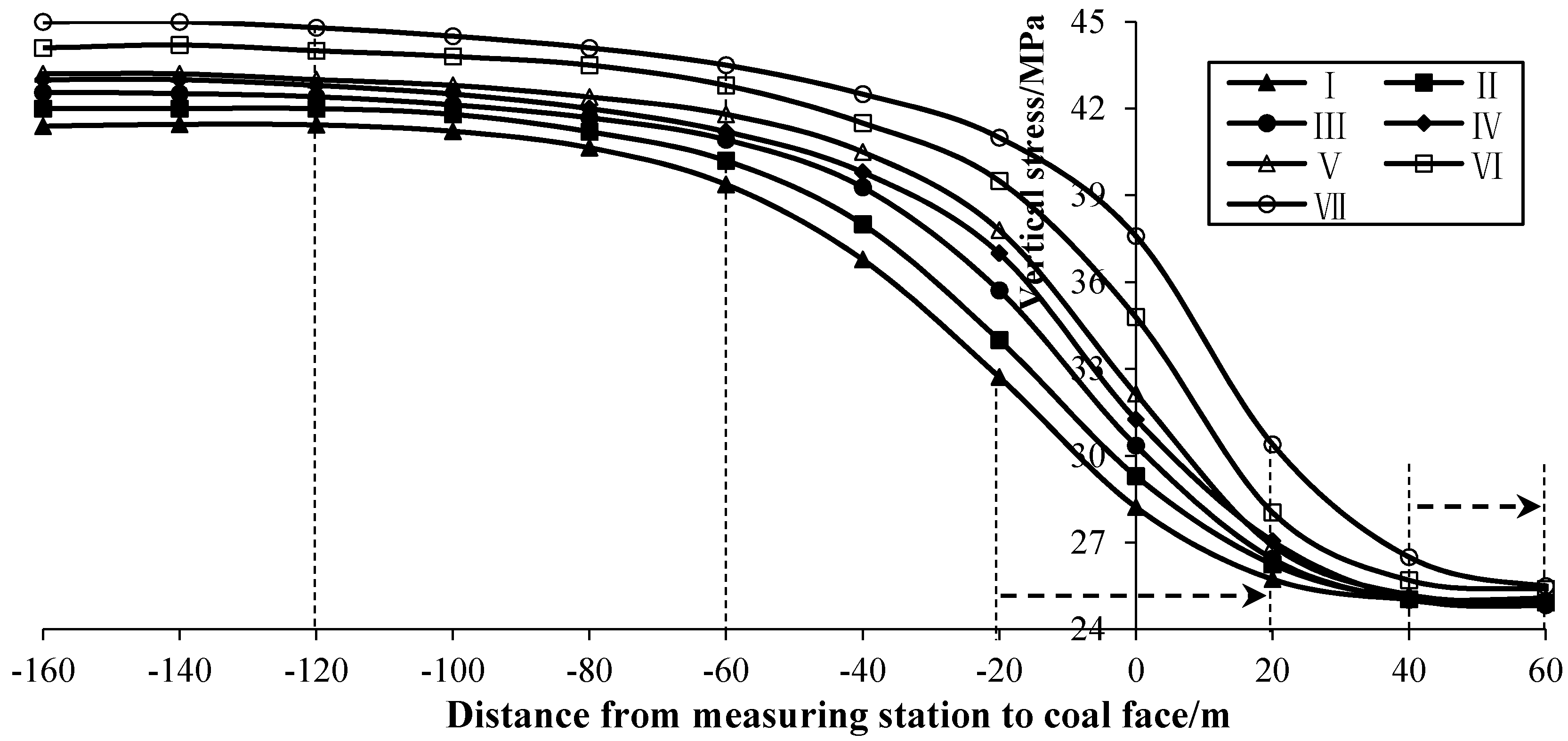
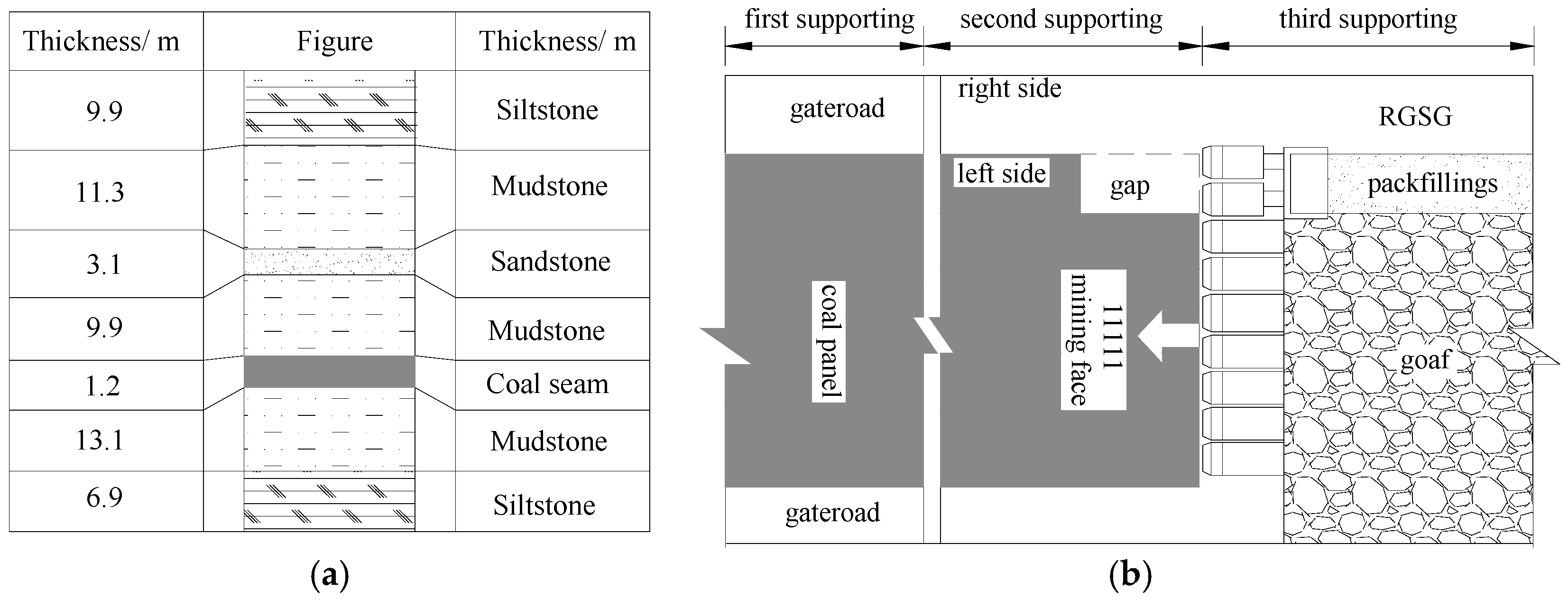

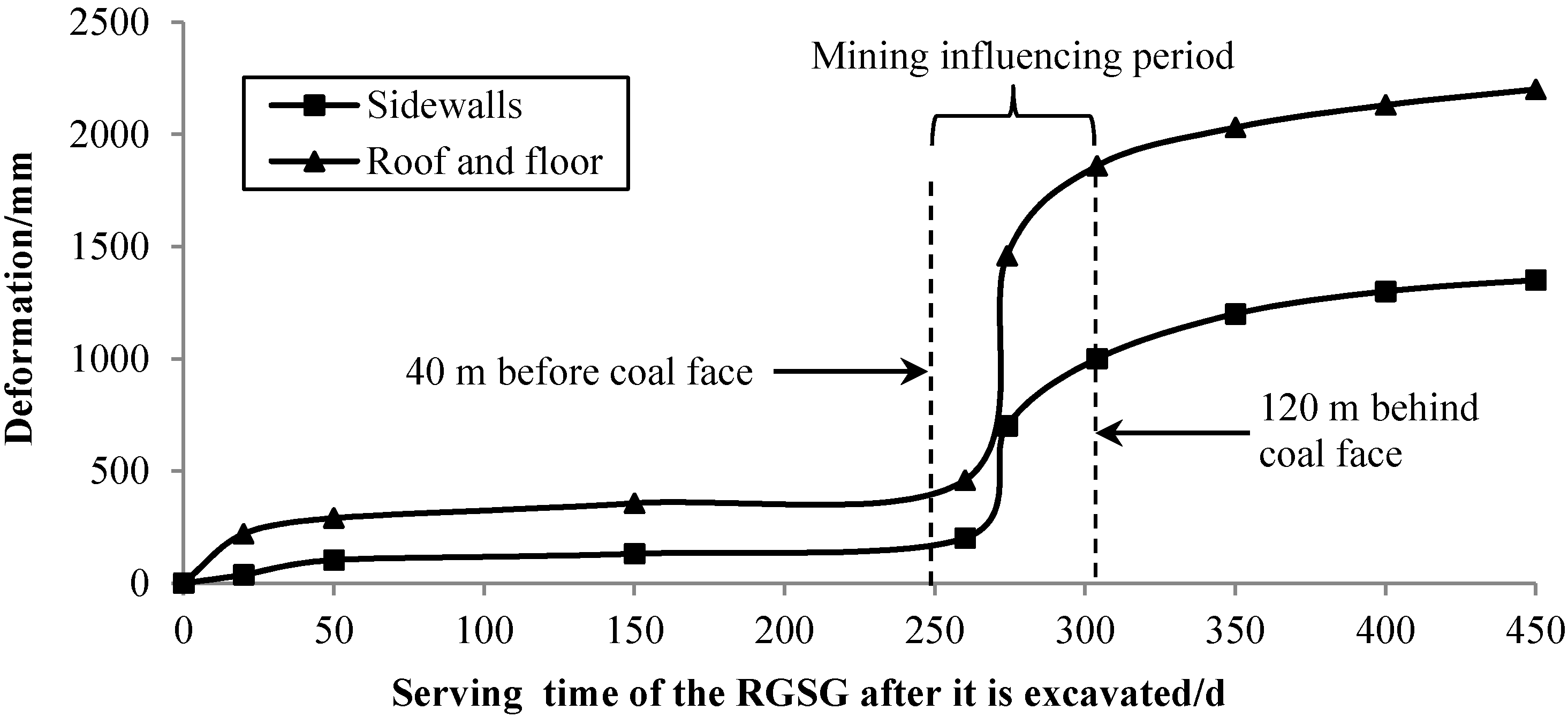
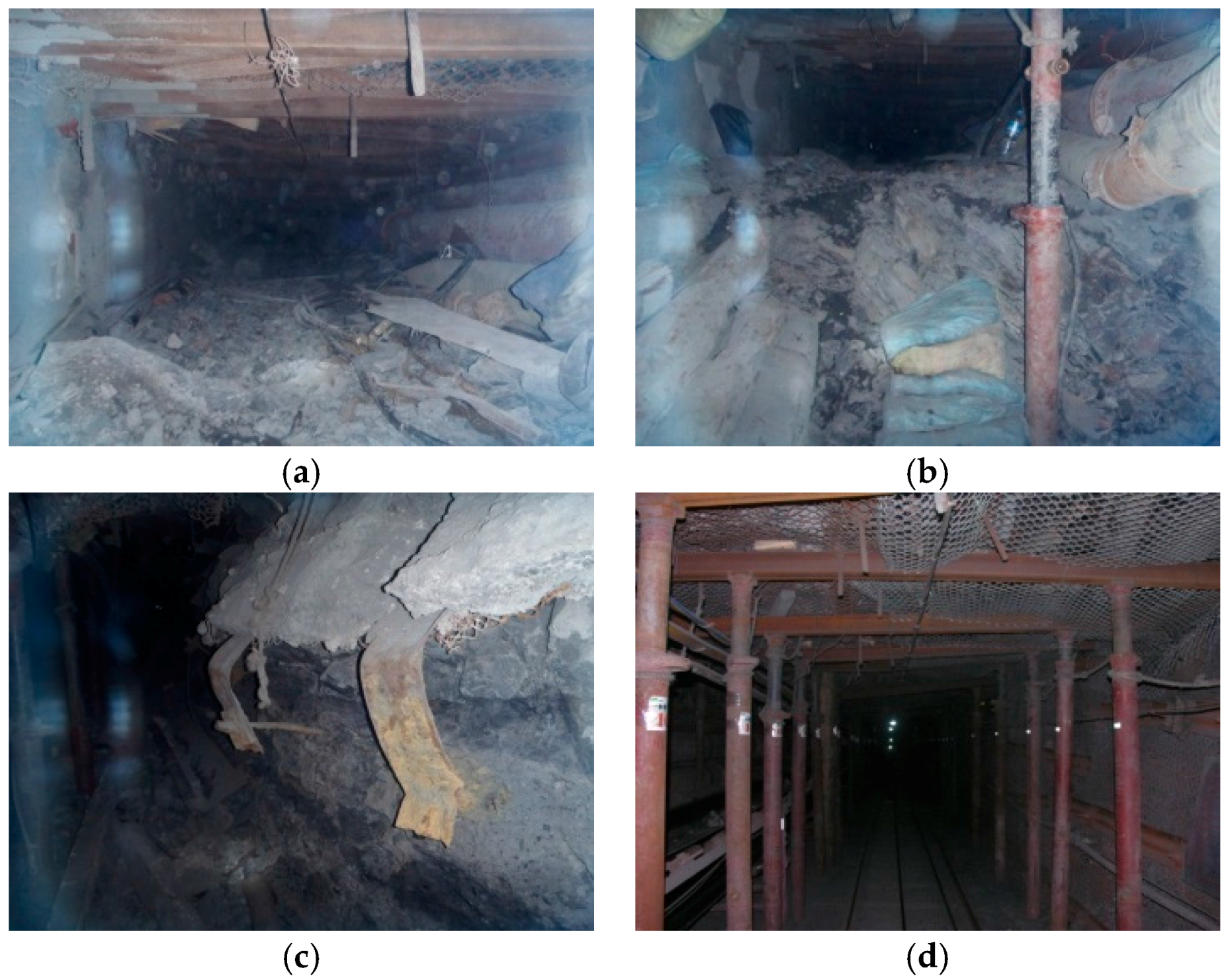
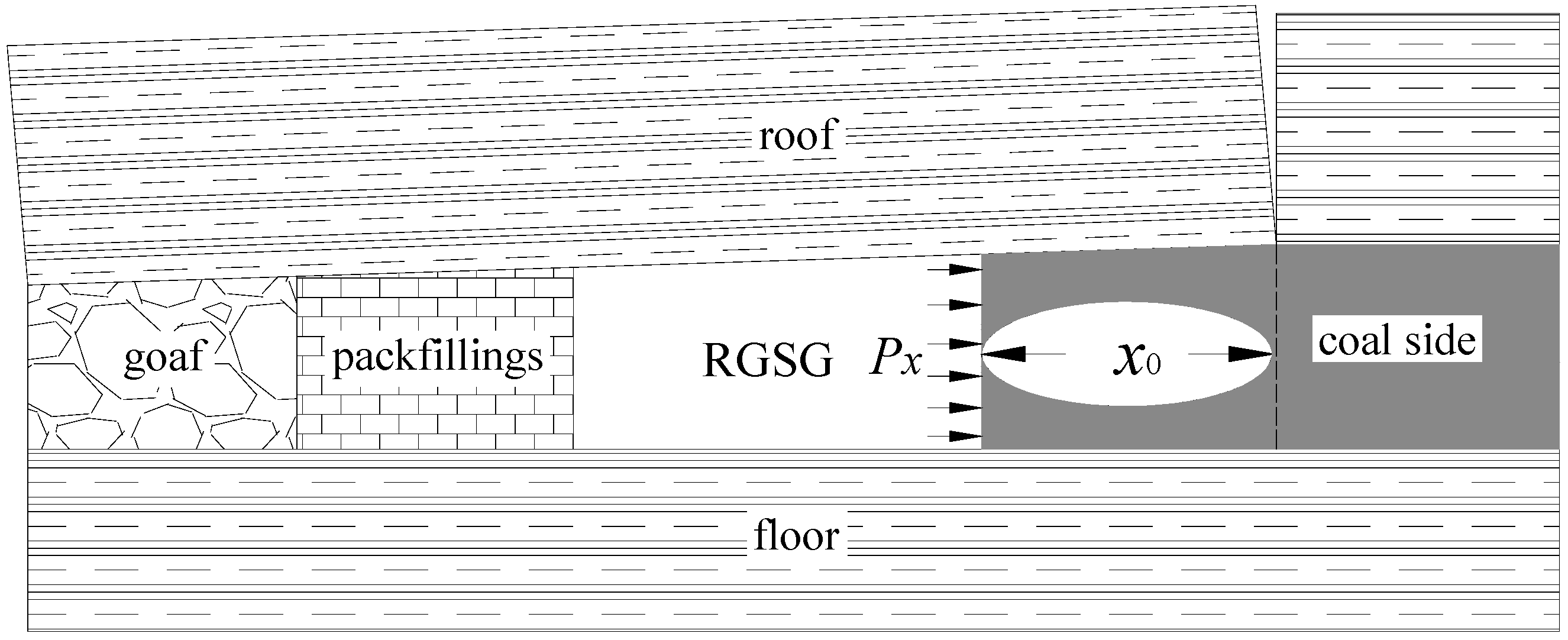

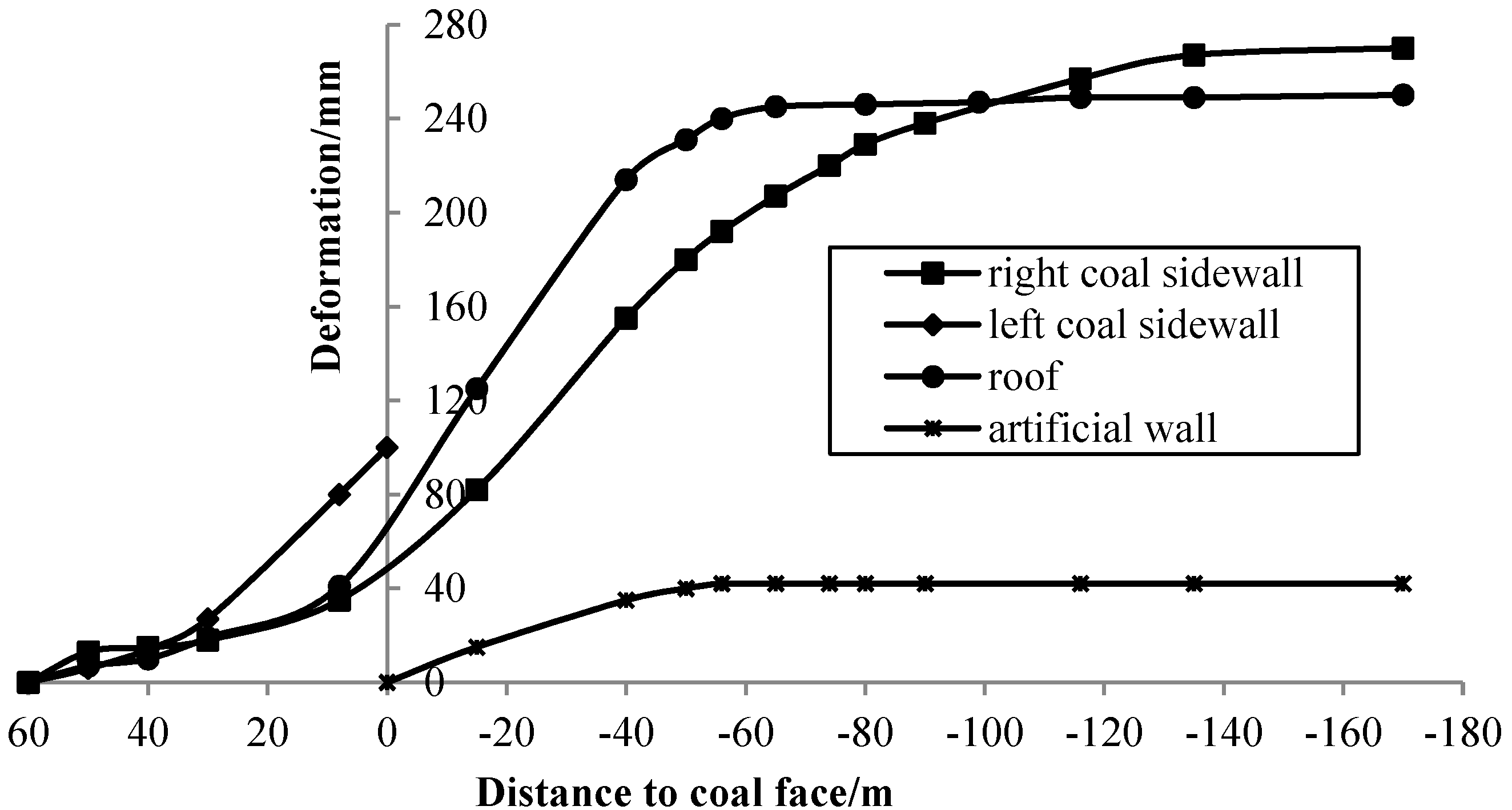

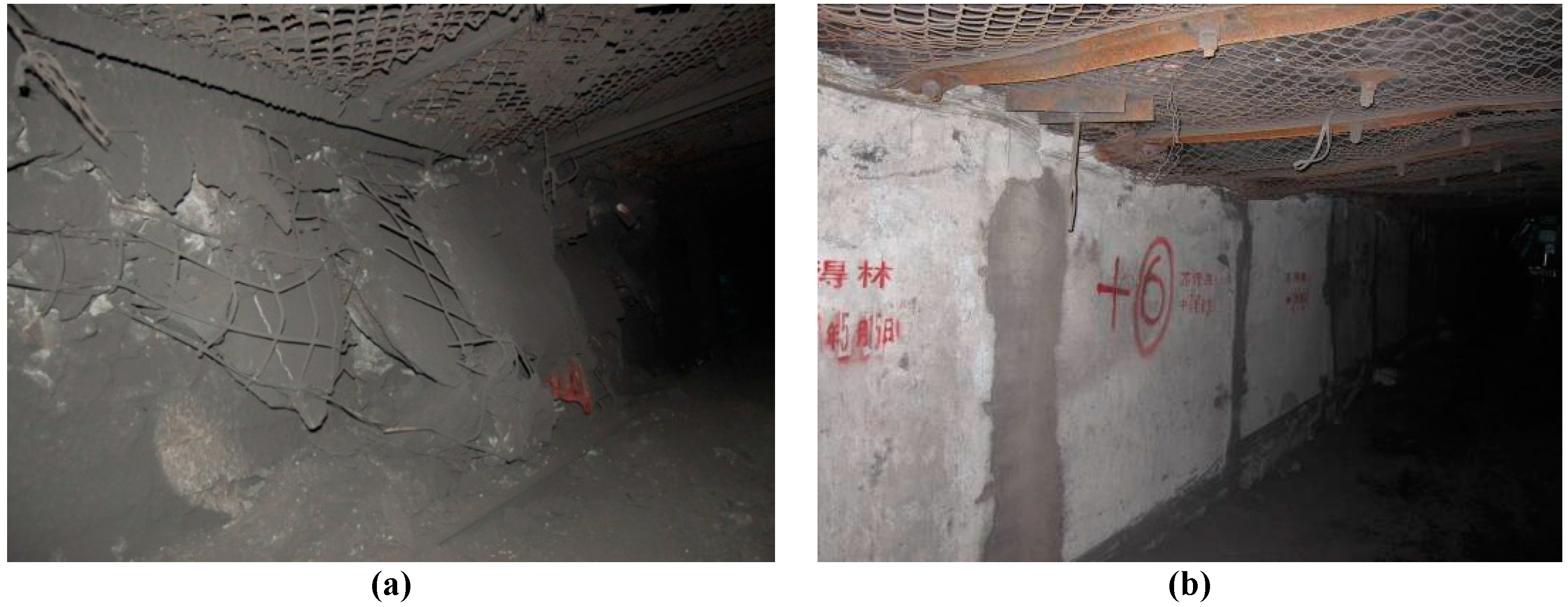
| Roof Conditions | Thickness of Coal Seam m/m | Thickness of Immediate Roof h1/m | Thickness of Main Roof h2/m | Thickness of Backfilling h3/m | Subsidence of Main Roof Δh/m |
|---|---|---|---|---|---|
| I | 3.0 | 12.0 | 0 | 15.0 | 0 |
| II | 3.0 | 10.0 | 2.0 | 12.5 | 0.5 |
| III | 3.0 | 8.0 | 4.0 | 10.0 | 1.0 |
| IV | 3.0 | 6.0 | 6.0 | 7.5 | 1.5 |
| V | 3.0 | 4.0 | 8.0 | 5.0 | 2.0 |
| VI | 3.0 | 2.0 | 10.0 | 2.5 | 2.5 |
| VII | 3.0 | 0 | 12.0 | 0 | 3.0 |
| Strata | Density | Bulk Modulus | Shear Modulus | Cohesion | Friction Angle |
|---|---|---|---|---|---|
| (kg/m3) | (GPa) | (GPa) | (MPa) | (°) | |
| Siltstone | 2600 | 3.03 | 1.84 | 1.5 | 28 |
| Mudstone | 2400 | 2.68 | 1.56 | Table 3 | Table 3 |
| Coal | 1450 | 1.19 | 0.37 | Table 3 | Table 3 |
| Sandstone | 2700 | 5.40 | 4.00 | 2.2 | 33 |
| Packfillings | 2500 | 4.50 | 3.00 | 2.0 | 30 |
| Mechanical Parameters | Mudstone | Coal | ||
|---|---|---|---|---|
| Plastic shear strain | 0 | 0.1 | 0 | 0.1 |
| Cohesion/(MPa) | 1.2 | 0.12 | 0.8 | 0.08 |
| Friction angle/(°) | 27 | 24 | 23 | 20 |
© 2017 by the authors. Licensee MDPI, Basel, Switzerland. This article is an open access article distributed under the terms and conditions of the Creative Commons Attribution (CC BY) license (http://creativecommons.org/licenses/by/4.0/).
Share and Cite
Zhang, Z.; Shimada, H.; Sasaoka, T.; Hamanaka, A. Stability Control of Retained Goaf-Side Gateroad under Different Roof Conditions in Deep Underground Y Type Longwall Mining. Sustainability 2017, 9, 1671. https://doi.org/10.3390/su9101671
Zhang Z, Shimada H, Sasaoka T, Hamanaka A. Stability Control of Retained Goaf-Side Gateroad under Different Roof Conditions in Deep Underground Y Type Longwall Mining. Sustainability. 2017; 9(10):1671. https://doi.org/10.3390/su9101671
Chicago/Turabian StyleZhang, Zhiyi, Hideki Shimada, Takashi Sasaoka, and Akihiro Hamanaka. 2017. "Stability Control of Retained Goaf-Side Gateroad under Different Roof Conditions in Deep Underground Y Type Longwall Mining" Sustainability 9, no. 10: 1671. https://doi.org/10.3390/su9101671





